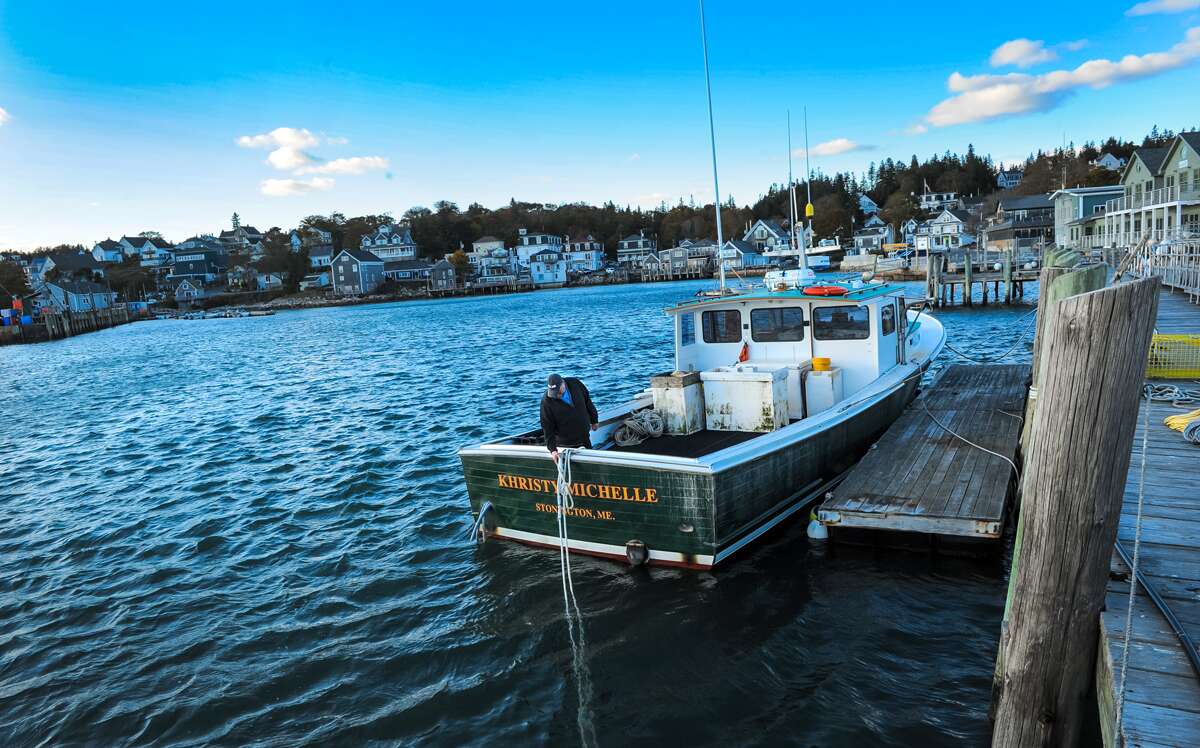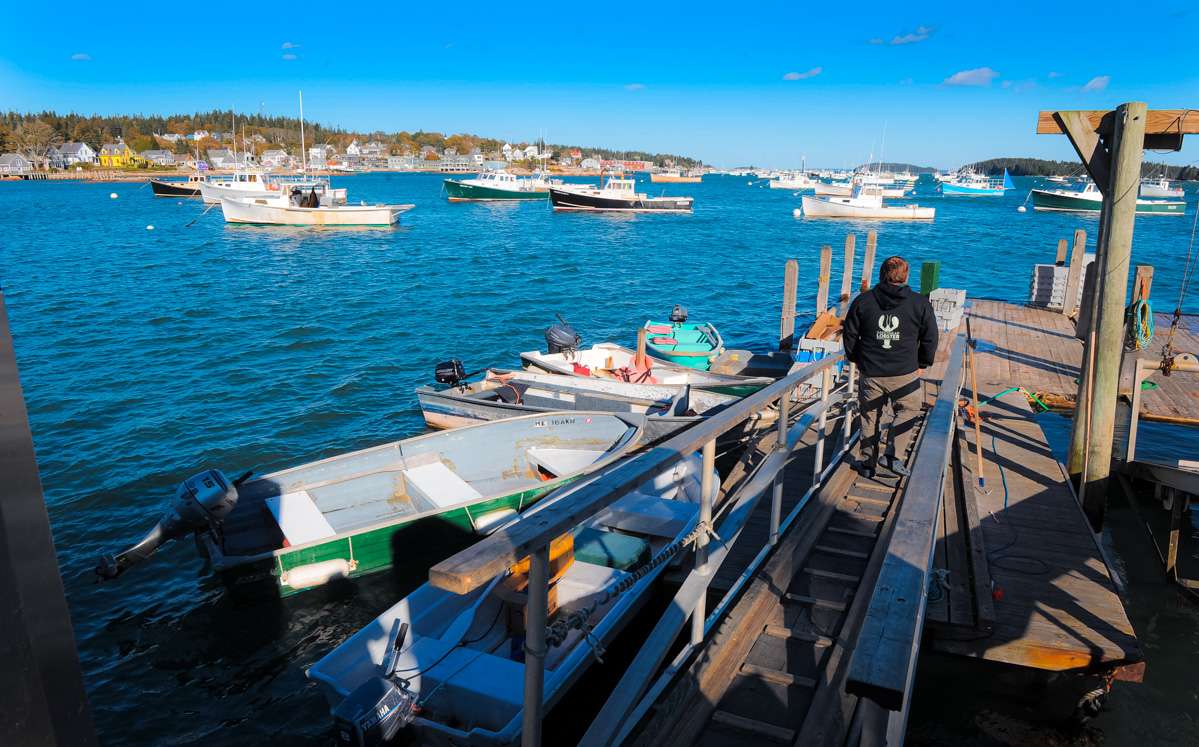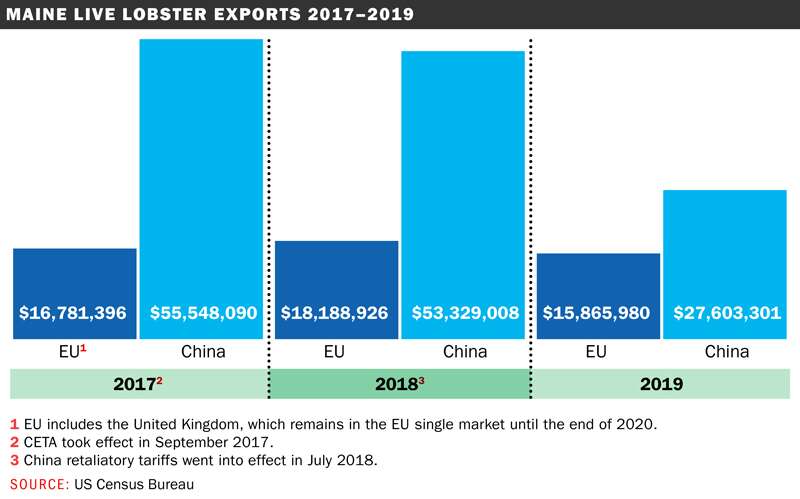
Processing Your Payment
Please do not leave this page until complete. This can take a few moments.
- News
-
Editions
View Digital Editions
Biweekly Issues
- December 1, 2025
- Nov. 17, 2025
- November 03, 2025
- October 20, 2025
- October 6, 2025
- September 22, 2025
- + More
Special Editions
- Lists
- Viewpoints
-
Our Events
Event Info
Award Honorees
- Calendar
- Biz Marketplace
Despite an uncertain start to the fishery's season, lobster rolls on
 Photo / Fred Field
John Williams is one of the Stonington lobstermen who has seen his business change as the industry pivoted to new markets.
Photo / Fred Field
John Williams is one of the Stonington lobstermen who has seen his business change as the industry pivoted to new markets.
Stonington lobster fisherman John Williams usually hauls his boat out in February for annual maintenance and paint in preparation for the start of the spring fishing season.
“Then COVID started,” he says.
The health emergency was worsening and the economy shutting down. That included one of the lobster industry’s biggest markets — restaurants. The large cruise ship and casino markets also slammed shut. International freight and shipping to China, emerging as a large consumer of lobster, had nearly stopped.
“I got thinking about it and said, ‘This doesn’t look very good. We won’t have any market,’” Williams says.
Dealers were saying they couldn’t move product. Williams almost removed his traps from the water. Then one dealer — a family member — said he could use a few lobsters. So Williams called his regular dealer.
“I said, ‘What’ going on?’” he remembers. “He said, ‘I’ll take them.’ In two weeks, things changed.”

Finding new markets
The Maine Lobster Marketing Collaborative and individual dealers scrambled to find new retail markets — catering to home chefs, advertising on consumer media outlets such as Real Simple and Thrillist, and building on existing relationships with grocers. The collaborative developed media content on how to cook lobster, how to shuck lobster — all the things that might be handled at a restaurant.
Since summer’s start, there’s been a flurry of lobster consumption through direct-to-consumer sales online and in grocery stores, says Hugh Reynolds, owner of Greenhead Lobster, a Stonington lobster dealership. Reynolds leveraged relationships with retailers that wanted to promote more lobster, including value-added products he was developing at a Bucksport processing plant he opened last year.
The consumers were home cooks and folks craving a night out when restaurants started outdoor seating.
“People had not had a night out in months and lobster seemed to be the ‘home treat’ of choice,” Reynolds writes on his blog. “And when people did start to go out, New England-style lobster shacks across the country were the ideal setting for an outdoor meal. Lobster rolls are a good ‘take-out’ option and a classic summer meal, and the demand has been there despite the challenges.”
“The big pivot seems to have been into retail and into direct-to-consumer sales,” says Patrice McCarron, executive director of the Maine Lobstermen’s Association. “It was difficult to comprehend how lobster would go into retail in a meaningful enough way to m
ake up for the lack of restaurants and food service. But it appears that sector has grown significantly and has accounted for a bigger market share than it has traditionally been, and it seems to be a fairly stable segment.”
“I give credit to the dealers,” says Stonington fisherman Frank Gotwals. “They really made an effort to move toward home sales and supermarkets.”
Stunning value
For Stonington, the shift is meaningful. With a population just over 1,000, according to the 2010 census, its harbor is home to between 300 and 400 fishing vessels, each run as an independent business by its captain and employing one or two stern men. The small Hancock County village, on the south end of Deer Isle, is Maine’s biggest lobster fishing port.
Along its winding main road are traditional seafood dealer wharfs, views of the sea and islands, and a tiny downtown featuring bed-and-breakfasts, the early-20th-century Stonington Opera House and a granite museum displaying artifacts of the quarries once a big driver of the local economy.
Today, the lobster fishery is Stonington’s economic engine.
“Stonington is kind of unique,” says Town Manager Kathleen Billings. “We’re closest to the fishing grounds.”
In addition to direct jobs, lobstering is twined into the community’s larger economy.
“We have the marine hardware stores, the people who do the trucking, the bait businesses. There are the garages that fix the trucks,” says Billings.
There’s the downtown grocery.
“He opens at 3 or 4 o’clock in the morning and there’s a line out the door, with the guys going in to get food before they head out on their boats,” she says.
The activity also attracts visitors.
“Tourists go to Bar Harbor to see the park, they go north to see the moose and they come here to see the lobstermen,” she continues.
Although the value of Stonington’s lobster landings declined from $68 million in 2016 to $51 million in 2019, the town has outranked other ports for at least the past five years. “It’s a stunning value, when you think of putting that much money into the economy of an island,” says Robin Alden, a co-founder of Stonington’s Maine Center for Coastal Fisheries.
Season of just-enough
Statewide, says McCarron, “There was a ton of anxiety going into the season when the pandemic hit, because restaurants and food service shut down and over three-quarters of seafood is consumed in restaurants.”
She adds, “We were wondering, No. 1, if fishermen fished, would there be a market for their product?”
Fishermen were also concerned the per-pound price paid to them would not be high enough to cover their costs. Some fishermen shifted operations going into the season in order to avoid overburdening the supply chain.
“Anecdotally, I’ve heard of older people not setting gear,” McCarron says. “People were being careful about the number of traps they set.”
But the timing of the pandemic’s start is considered something of a silver lining. Early spring is always slow for the fishery.
“By and large, the lobster fishery lucked out,” says Carla Guenther, chief scientist at the Maine Center for Coastal Fisheries. “People were able to shift to direct marketing, because we didn’t have the high volume coming in.”
As of mid-September, lobsters also hadn’t been as plentiful as they usually are at that time of year. So the market, as it geared up, has been able to absorb available product.
“I think the lobster haven’t struck yet in their full bloom,” says Reynolds. “But we’re still anticipating a good fall like we had last year.”

Scarcity helped boost payments to fishermen, who are seeing per-pound prices of $4.50 or more — close to what they saw at this time a year ago.
Combined with “surprisingly healthy retail demand, prices have been a lot stronger than what we anticipated in the midst of COVID in March and April,” says Reynolds.
“It’s like the stars have been in alignment to allow us to limp along as opposed to crash,” says Guenther. “It’s a season of just-enough.”
The outlook
“We’re taking it a day at a time,” says McCarron. “We’ve been really pleased that the dealers and processers have been so effective in building new markets. We hope those continue. But I wouldn’t want to guess what next week or next month brings in this pandemic economy. I think everyone will continue to be cautious.”
Billings, the town manager, also worries about the pandemic’s long-term effect. “We’re really only in the first few months of the pandemic and it’s likely to have profound ecomic consequences coming up,” says Billings. “That makes me afraid. We’re a town that’s really dependent on the resource-based economy.”
But, she adds, “Fishermen are smart and resilient. They’ll dig in.”
On a September afternoon, Williams had recently returned from hauling traps.
“Today, we haven’t had a big day,” he says. “But if we get 500 pounds and we do it six days a week, it’s a week of work. So business is normal.”
He adds, “Things have been way better than we expected.”
Home cooks
The economic shutdown in March gave the Maine Lobster Marketing Collaborative time to develop new marketing content before summer harvesting ramped up and well before the peak of the harvest season, which starts in the fall.
In the past, campaigns focused on restaurant consumption. This year, the goal was to reach people who wanted to prepare lobster at home but didn’t know how. A new home cooks hub provides recipes and videos. Visits to the “Shipped to Your Home” page increased 245% comparing July 2020 to July 2019. The collaborative is also working with distributors and retailers to set up store promotions and retail ads and digital materials about lobster.
Trade wars

Maine’s lobstering industry got a boost in August when the European Union announced an end to tariffs on imports of U.S. lobster.
In 2017, the EU was a top destination for American lobster, accounting for 15% to 20% of annual exports. Unlike Canadians, American exporters faced tariffs of 8% for live lobster and up to 30% for frozen products.
Retaliatory tariffs imposed by China in 2018 remain in effect. Previously, China was the second-largest importer of Maine lobster, in 2017.
In September, the U.S. Department of Agriculture announced a Seafood Trade Relief Program that could award $50 million to lobstermen, based on a rate of 50 cents per pound multiplied by pounds landed in 2019.
Mainebiz web partners

The Giving Guide
The Giving Guide helps nonprofits have the opportunity to showcase and differentiate their organizations so that businesses better understand how they can contribute to a nonprofit’s mission and work.
Learn More
Work for ME
Work for ME is a workforce development tool to help Maine’s employers target Maine’s emerging workforce. Work for ME highlights each industry, its impact on Maine’s economy, the jobs available to entry-level workers, the training and education needed to get a career started.
Learn More
Groundbreaking Maine
Whether you’re a developer, financer, architect, or industry enthusiast, Groundbreaking Maine is crafted to be your go-to source for valuable insights in Maine’s real estate and construction community.
Learn more-
The Giving Guide
The Giving Guide helps nonprofits have the opportunity to showcase and differentiate their organizations so that businesses better understand how they can contribute to a nonprofit’s mission and work.
-
Work for ME
Work for ME is a workforce development tool to help Maine’s employers target Maine’s emerging workforce. Work for ME highlights each industry, its impact on Maine’s economy, the jobs available to entry-level workers, the training and education needed to get a career started.
-
Groundbreaking Maine
Whether you’re a developer, financer, architect, or industry enthusiast, Groundbreaking Maine is crafted to be your go-to source for valuable insights in Maine’s real estate and construction community.
ABOUT
NEW ENGLAND BUSINESS MEDIA SITES
No articles left
Get access now
In order to use this feature, we need some information from you. You can also login or register for a free account.
By clicking submit you are agreeing to our cookie usage and Privacy Policy
Already have an account? Login
Already have an account? Login
Want to create an account? Register
Get access now
In order to use this feature, we need some information from you. You can also login or register for a free account.
By clicking submit you are agreeing to our cookie usage and Privacy Policy
Already have an account? Login
Already have an account? Login
Want to create an account? Register







0 Comments